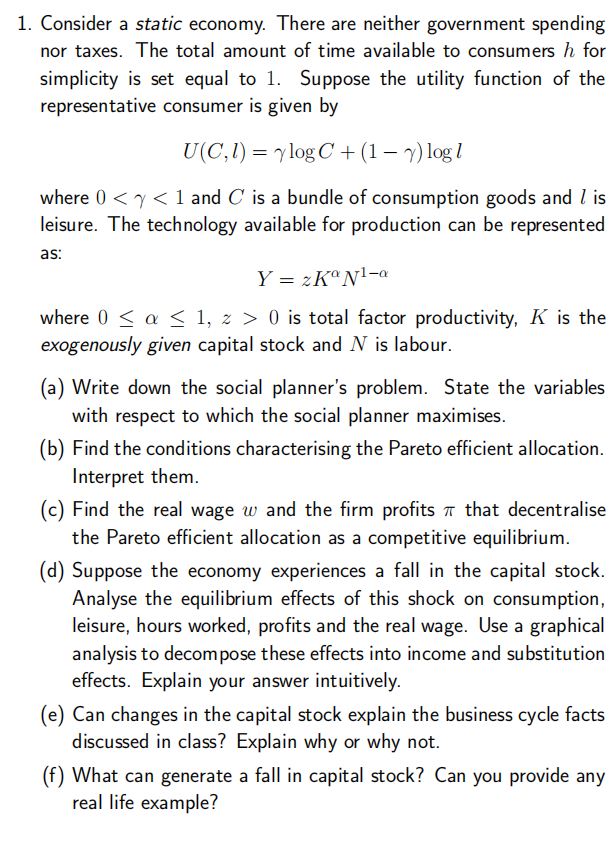1. Consider a static economy. There are neither government spending nor taxes. The total amount of time available to consumers h for simplicity is set equal to 1. Suppose the utility function of the representative consumer is given by U(C,1)= y log C+ (1 - y) logl where 0 << 1 and C is a bundle of consumption goods and I is leisure. The technology available for production can be represented as: Y = 2KaN¹-a where 0 ≤ a ≤ 1, z > 0 is total factor productivity, K is the exogenously given capital stock and N is labour. (a) Write down the social planner's problem. State the variables with respect to which the social planner maximises. (b) Find the conditions characterising the Pareto efficient allocation. Interpret them. (c) Find the real wage w and the firm profits that decentralise the Pareto efficient allocation as a competitive equilibrium.
1. Consider a static economy. There are neither government spending nor taxes. The total amount of time available to consumers h for simplicity is set equal to 1. Suppose the utility function of the representative consumer is given by U(C,1)= y log C+ (1 - y) logl where 0 << 1 and C is a bundle of consumption goods and I is leisure. The technology available for production can be represented as: Y = 2KaN¹-a where 0 ≤ a ≤ 1, z > 0 is total factor productivity, K is the exogenously given capital stock and N is labour. (a) Write down the social planner's problem. State the variables with respect to which the social planner maximises. (b) Find the conditions characterising the Pareto efficient allocation. Interpret them. (c) Find the real wage w and the firm profits that decentralise the Pareto efficient allocation as a competitive equilibrium.
Chapter1: Making Economics Decisions
Section: Chapter Questions
Problem 1QTC
Related questions
Question

Transcribed Image Text:1. Consider a static economy. There are neither government spending
nor taxes. The total amount of time available to consumers h for
simplicity is set equal to 1. Suppose the utility function of the
representative consumer is given by
U(C, 1) = ylog C+ (1 - 7) log l
where 0 << 1 and C is a bundle of consumption goods and I is
leisure. The technology available for production can be represented
as:
Y = 2KaN¹-a
where 0 ≤ a ≤ 1, z > 0 is total factor productivity, K is the
exogenously given capital stock and N is labour.
(a) Write down the social planner's problem. State the variables
with respect to which the social planner maximises.
(b) Find the conditions characterising the Pareto efficient allocation.
Interpret them.
(c) Find the real wage w and the firm profits that decentralise
the Pareto efficient allocation as a competitive equilibrium.
(d) Suppose the economy experiences a fall in the capital stock.
Analyse the equilibrium effects of this shock on consumption,
leisure, hours worked, profits and the real wage. Use a graphical
analysis to decompose these effects into income and substitution
effects. Explain your answer intuitively.
(e) Can changes in the capital stock explain the business cycle facts
discussed in class? Explain why or why not.
(f) What can generate a fall in capital stock? Can you provide any
real life example?
Expert Solution
This question has been solved!
Explore an expertly crafted, step-by-step solution for a thorough understanding of key concepts.
Step by step
Solved in 3 steps

Knowledge Booster
Learn more about
Need a deep-dive on the concept behind this application? Look no further. Learn more about this topic, economics and related others by exploring similar questions and additional content below.Recommended textbooks for you


Principles of Economics (12th Edition)
Economics
ISBN:
9780134078779
Author:
Karl E. Case, Ray C. Fair, Sharon E. Oster
Publisher:
PEARSON

Engineering Economy (17th Edition)
Economics
ISBN:
9780134870069
Author:
William G. Sullivan, Elin M. Wicks, C. Patrick Koelling
Publisher:
PEARSON


Principles of Economics (12th Edition)
Economics
ISBN:
9780134078779
Author:
Karl E. Case, Ray C. Fair, Sharon E. Oster
Publisher:
PEARSON

Engineering Economy (17th Edition)
Economics
ISBN:
9780134870069
Author:
William G. Sullivan, Elin M. Wicks, C. Patrick Koelling
Publisher:
PEARSON

Principles of Economics (MindTap Course List)
Economics
ISBN:
9781305585126
Author:
N. Gregory Mankiw
Publisher:
Cengage Learning

Managerial Economics: A Problem Solving Approach
Economics
ISBN:
9781337106665
Author:
Luke M. Froeb, Brian T. McCann, Michael R. Ward, Mike Shor
Publisher:
Cengage Learning

Managerial Economics & Business Strategy (Mcgraw-…
Economics
ISBN:
9781259290619
Author:
Michael Baye, Jeff Prince
Publisher:
McGraw-Hill Education